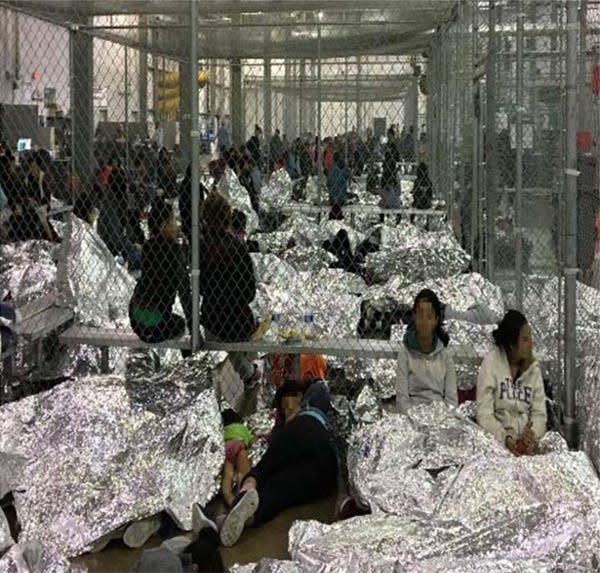Trump immigration change would all but end asylum requests for Central American migrants
WASHINGTON – The Trump administration moved Monday to prevent most migrants from claiming political asylum in the USA, requiring them to make their claims in other countries first.
The proposed rule will almost certainly be challenged in court. Previous administration attempts to restrict asylum claims have been struck down.
The proposal "will decrease forum shopping by economic migrants and those who seek to exploit our asylum system to obtain entry to the United States," Attorney General William Barr said in a statement.
Lee Gelernt, an American Civil Liberties Union attorney who led the lawsuit that forced the administration to reunite more than 2,800 migrant families separated under Trump’s “zero tolerance” policy, said Monday morning his team would file a lawsuit soon against Trump’s latest move.
“The rule is unlawful, period,” Gelernt said. “We will be in court immediately to block the rule. It effectively ends asylum for anybody approaching the southern border and could not be more inconsistent with our country’s commitment to provide safe haven for those fleeing danger.”
Under the rule published Monday in the Federal Register, asylum seekers who pass through another country first will be ineligible for asylum at the U.S. southern border. For example, a Honduran who passes through Guatemala and Mexico would be barred from requesting asylum in the USA under the argument that they could have applied for asylum in either of those two countries.
The rule is based on the concept of requesting asylum in a "safe third country." It sidesteps U.S. law that requires the federal government to have a "safe third country" agreement in place verifying that a country is considered safe.
The proposal does provide limited exceptions. Barr said the government would work to make sure that "no one is removed from the United States who is more likely than not to be tortured or persecuted on account of a protected ground."
The plan is scheduled to got into effect Tuesday.
Critics said the practical effect is to all but end asylum requests, and they predicted the courts would strike down the effort.
"Once again, the Trump administration is attempting to rewrite laws passed by Congress to protect refugees from return to persecution," said Eleanor Acer, senior director for refugee protection at Human Rights First. "The president can’t stand the fact that seeking protection in the United States is legal, so he’s doing everything he can to make the asylum process as difficult as possible."
It's unclear how much other countries would cooperate on new asylum rules.
Trump was supposed to meet Monday with Guatemalan President Jimmy Morales to discuss a "safe third country" agreement for asylum seekers. Guatemala announced the meeting was canceled because the courts are considering whether Morales can make such an agreement.
"The government of the republic reiterates that at no moment has it contemplated signing an agreement to convert Guatemala into a safe third country," the government said in a statement.
Mexico's Foreign Minister Marcelo Ebrard told reporters in Mexico City on Monday that he disagreed with the new policy, but said there was nothing his government could do since it was a unilateral move imposed by the Trump administration.
Ebrard, who led negotiations with Washington last month that resulted in Mexico deploying thousands of National Guard troops to stem the flow of migrants through the country, said Mexico has not entered into a "safe third party" agreement with the U.S., and wouldn't do so without the backing of its Congress.
The proposal is the latest attempt by the Trump administration to unilaterally limit or halt migrants from requesting asylum at the southwest border.
In June 2018, the Department of Justice introduced a policy cutting off asylum for victims of domestic abuse and gang violence. In November, Justice and Homeland Security issued a plan to block migrants who enter the country illegally from requesting asylum. Both those policies were blocked by federal judges.

Starting in December, the administration tried a different approach. Homeland Security announced a “Remain in Mexico” plan to force migrants who applied for asylum to return to Mexico to await the outcome of their application. That policy was temporarily blocked by a federal judge, but the 9th U.S. Circuit Court of Appeals – a longtime target of Trump over its rulings striking down several of his policies – handed the president a victory and allowed the policy to go into effect.
That policy, formally known as the Migrant Protection Protocols, has led to more than 10,000 migrants returning to Mexico where they live in Mexican border towns waiting for word.
In April, Trump signed a presidential memorandum ordering the Justice and Homeland Security departments to create rules that would, for the first time, require asylum seekers to pay an application fee. The president said such a fee is necessary to ensure the asylum system isn’t undermined by false asylum claims, but critics contend it’s an attempt to punish Central American migrants who are poor and vulnerable.
Contributing: Rafael Carranza, Arizona Republic.
This article originally appeared on USA TODAY: Trump plans to end most migrant asylum requests from Central Americans
